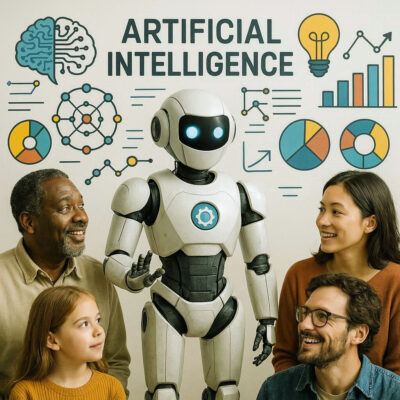For Small Businesses

AI is showing up everywhere in marketing, from smarter ads to personalized customer rides. If a lot of the terminology sounds like another language, you’re not alone. Here’s a clear, no-jargon guide to the AI buzzwords every marketer comes across. Understanding these terms will save you time and help you talk shop with your team, agency, or vendors.
AI Basics for Marketers
What is Artificial Intelligence?
Artificial Intelligence (or AI) basically means any technology that uses data and algorithms to make decisions, predictions, or automate tasks. For marketers, think of AI as the tech behind things like automated product recommendations, customer support chatbots, and smart ad targeting. It helps run behind-the-scenes systems that keep everything moving, often faster and with more accuracy.
How is Machine Learning Different?
Machine Learning (ML) is a type of AI that “learns” from data. Instead of a program that always performs the same steps, ML systems spot trends in the data and get smarter over time. If you’ve ever seen an email subject line being optimized by AI or a lookalike audience built on social ads, that’s ML in action. It’s like having an assistant who gets better at spotting patterns and making solid suggestions as they learn more about your business.
What Does Natural Language Processing Mean?
Natural Language Processing (NLP) lets computers understand and generate human language. In digital marketing, NLP powers chatbots, sentiment analysis tools that scan comments and reviews, and much of the content creation magic you see from AI writing assistants. This helps brands communicate in a more authentic way and keeps automated responses feeling friendly and relevant.
AI in Action: Practical Marketing Terms
What is Predictive Analytics?
Predictive analytics uses AI to forecast future outcomes based on historical data. Marketers use it to figure out which leads are most likely to convert, when someone might unsubscribe, or what kind of email campaign might perform best. If you want to stay ahead of customer trends, predictive analytics is super useful. It lets you plan campaigns more confidently and helps cut down on wasted marketing dollars.
What are Lookalike Audiences?
Lookalike audiences are groups of new people who “look like” your current customers, selected by AI tools based on behavior and demographics. Ads get shown to these groups, making targeting more efficient and helping you find potential fans you might have missed otherwise. Building these audiences with AI tools makes connecting with the right new leads faster and easier for brands big and small.
What is Programmatic Advertising?
Programmatic advertising is all about using AI to buy, place, and optimize digital ads automatically. It analyzes tons of real-time data to get your ads in front of the right people at the right moment. Marketers see more value from their ad budgets without endless manual tweaks. With programmatic ad buying, even a small team can keep their campaigns running smoothly and hit their goals faster.
Common AI Powered Tools Explained
How Do Chatbots Work?
Chatbots use AI and NLP to chat with website visitors or social media users. They answer common questions, suggest products, and handle simple support requests. Modern chatbots get better the more they interact with real people, creating smoother customer experiences and saving support teams a lot of time. Brands can use chatbots for support 24/7, and customers don’t have to wait for a live agent to get answers to frequently asked questions.
What is Sentiment Analysis?
Sentiment analysis is a tool powered by AI that reads online comments, reviews, or social posts and tries to figure out if they’re positive, negative, or neutral. Marketers use this info to gauge how people feel about their brand, spot trends, or react faster to PR issues before they get big. Using sentiment analysis helps you keep an eye out for brand reputation changes and take action before small problems grow bigger.
What are Recommendation Engines?
When you see, “You might also like” or “People also bought” on a website, a recommendation engine is running behind the scenes. These AI systems analyze what customers do and suggest next steps, products, or content, which increases engagement and sales. A good recommendation engine quietly boosts both the customer’s experience and your company’s bottom line.
Quick Reference Glossary
- Algorithm: The rules or steps an AI system uses to make decisions.
- Training Data: The info AI studies to learn patterns or predict future outcomes.
- Big Data: Massive sets of data that AI crunches for insights.
- Automation: Using AI to handle repetitive or time consuming marketing chores.
- Personalization: AI driven adjustments to emails, ads, or website content so they fit each user better.
- Conversion Rate Optimization (CRO): Using AI insights to improve the number of people taking action on your site.
Getting the Most from AI in Marketing
AI is changing the game for marketers, but it’s way easier to get results when you actually understand what the tech can (and can’t) do. Learning these terms lets you talk easily with vendors and internal teams, and helps you spot cool new opportunities that are worth a try. As you check out AI powered tools, focus on the terms above. You’ll be finding your way through this space confidently in no time. For even more on the basics, check out this AI marketing primer or ask your favorite marketing tool vendor about their AI features. If you want to stay on top of marketing trends, being familiar with AI lingo will give you a real edge.
Still Have Questions? Let’s Chat!
Have a term you keep hearing but aren’t sure about? Just reach out to me. I’m always up for helping marketers make sense of AI and get more confident using these tools. Together, we can jump into the fast moving world of marketing technology and help you stay ahead of the curve.
